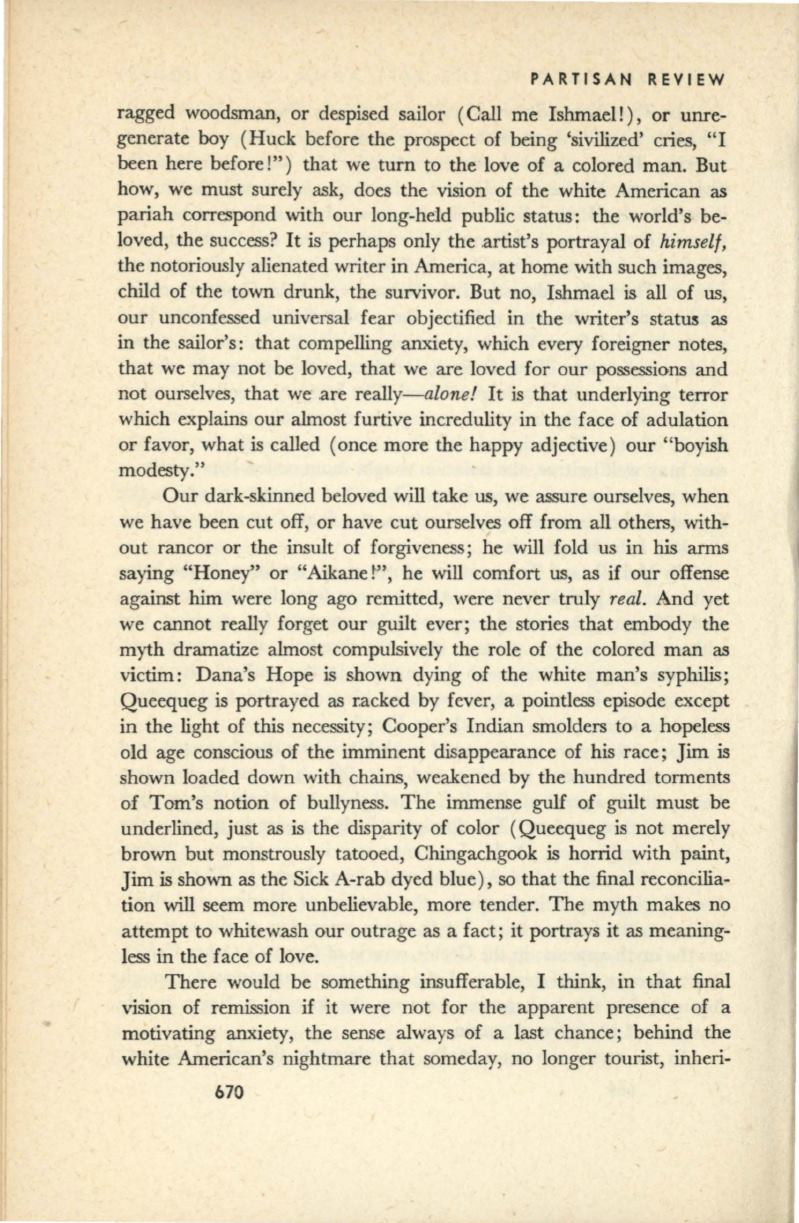
PARTISAN REVIEW
ragged woodsman, or despised sailor (Call me Ishmael! ) , or unre–
generate boy (Huck before the prospect of being 'sivilized' cries, "I
been here before!") that we turn to the love of a colored man. But
how, we must surely ask, does the vision of the white American as
pariah correspond with our long-held public status: the world's be–
loved, the success? It is perhaps only the .artist's portrayal of
himself,
the notoriously alienated writer in America, at home with such images,
child of the town drunk, the survivor. But no, Ishmael is all of us,
our unconfessed universal fear objectified in the writer's status as
in the sailor's: that compelling anxiety, which every foreigner notes,
that we may not be loved, that we are loved for our possessions and
not ourselves, that we are
really-alone!
It is that underlying terror
which explains our almost furtive incredulity in the face of adulation
or favor, what is called (once more the happy adjective) our "boyish
modesty."
Our dark-skinned beloved will take us, we assure ourselves, when
we have been cut off, or have cut ourselves off from all others, with–
out rancor or the insult of forgiveness; he will fold us in
his
arms
saying "Honey" or "Aikane
t",
he will comfort us, as if our offense
against
him
were long ago remitted, were never truly
real.
And yet
we cannot really forget our guilt ever; the stories that embody the
myth dramatize almost compulsively the role of the colored man as
victim: Dana's Hope is shown dying of the white man's syphilis;
Queequeg is portrayed as r.acked by fever, a pointless episode except
in the light of this necessity; Cooper's Indian smolders to a hopeless
old age conscious of the imminent disappearance of his race; Jim is
shown loaded down with chains, weakened by the hundred torments
of Tom's notion of bullyness. The immense gulf of guilt must be
underlined, just as is the disparity of color (Queequeg is not merely
brown but monstrously tatooed, Chingachgook is horrid with paint,
Jim is shown as the Sick A-rab dyed blue), so that the final reconcilia–
tion will seem more unbelievable, more tender. The myth makes no
attempt to whitewash our outrage as a fact; it portrays; it as meaning–
less in the face of love.
There would be something insufferable, I think, in that final
vision of remission if it were not for the apparent presence of a
motivating anxiety, the sense always of a last chance; behind the
white American's nightmare that someday, no longer tourist, inheri-
670


